(This article adapted from a 1995 review in Stereophile)
Digital Processor with HDCD decoding. Inputs: three coaxial on RCA lacks, two AES/EBU on XLRs, TosLink optical, Spectralink. Controls: digital input select, polarity inversion, mute, display dim, operate/standby. Sampling rates supported: 44.1kHz, 48kHz. D/A conversion: four custom 20-bit DACs in balanced configuration. digital filter: Pacific Microsonics PMD100 8x-oversampling. Analog filter: passive, linear phase to 22kHz. Frequency response: DC—22kHz ±3dB (limited by encoding). DAC step resolution: 5/LV or less. Digital noise output: 100 p-p or less. Intrinsic jitter: 8ps RMS, 20—25ps peak (attenuation corner frequency at 100Hz).
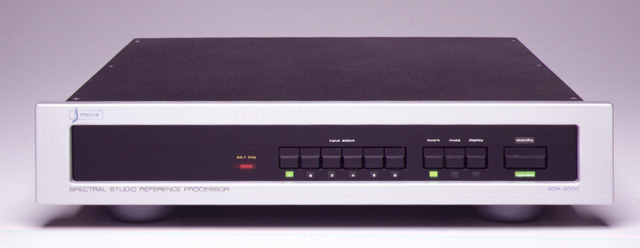
Analog outputs: unbalanced on RCA jacks balanced on XLRs. Output impedance: 100 Ohms
Analog stage frequency resp.: DC-1.2MHz -3da
Harmonic distortion: <0.002%.
Intermodulation distortion: <0.003% (SMPTE).
Signal/noise ratio: <120dB Channel sep.: 125dB
Pwr supply dissipation: 65W.
Dimensions: 19” W by 16” D by 4.25” H (SDR-2000); 6” W by 3.5” H by 13” D (DPS-2000 power supply).
Weight 52 lbs.
Price: $8195 (ca. 1995).
= = = =
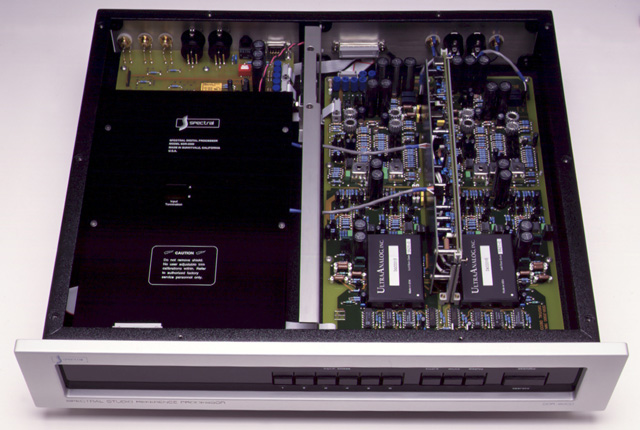
Spectral is a bit of an enigma in the high-end audio world. Although nearly 20 years old [in 1995] and one of the founders of the American high-end audio industry, Spectral isn’t a name that comes quickly to mind when considering the best of the best in high-end.
Spectral’s low profile is of their own choosing. They advertise very little; their products are demonstrated in a small number of stores, they almost never send products to magazines for review, and they are very quiet about their accomplishments. Rather than push their pro ducts on customers, they seem to let a small segment of the market discover on their own what a Spectral system can do. Consequently, Spectral relies heavily on the demonstration expertise of their dealers.
One reason for Spectral’s reticence to have their products reviewed is their belief that one of their components can not be evaluated properly when put into a system of other components. Theirs is a holistic approach to audio system design, and they hold that an entire Spectral system—including cables—is needed to hear the full musical capabilities of just one component. This requirement has meant that the only full reviews of Spectral products to have appeared in Stereophile have been Larry Greenhill’s of the DMC-10 preamplifier in the February 1984 issue (Vol.7 No.2), and A. Balgalvis’s of the MCR-1 phono cartridge in July 1989 (Vol.12 No.7).
TECHNICAL DESCRIPTION
The SDR-2000 Pro is a two-chassis unit composed of the processor itself and an outboard power supply, designated the DPS-2000. The supply is a smallish (6” by 3.4” by 13.3”) box that feeds DC to the processor through a ribbon cable and D-connectors.
The SDR-2000 Pro’s front-panel lay out, controls, and display are simple and intuitive. Six large buttons in a row each select one of six digital inputs. A second row of three identical-looking buttons inverts absolute polarity, mutes the out put, and dims the display. A larger but ton on the front panel’s right-hand side switches the unit between the operate and standby modes. This switch turns off the digital circuits and front-panel display, leaving the analog stages continuously powered. Small squares beneath each of these controls illuminate when the corresponding control is activated. The area to the left of the control buttons displays the input sampling rate, and the HDCD® logo illuminates when the SDR-2000 Pro is decoding an HDCD encoded disc. The sampling-rate display also serves as a lock indicator, illuminating only when the SDR-2000 Pro is locked to a digital source.
The rear panel holds three RCA digital input jacks, two AES/EBU inputs, one TosLink input, and the “Spectralink” data bus. Spectralink is a proprietary method of connecting a Spectralink equipped digital source to the SDR-2000 Pro. In this format, the audio data are transmitted on separate lines, and the SDR-2000 Pro serves as the master clock, forcing the transport to slave to the processor, reducing jitter. A Spectral transport with Spectralink output will be available later this year. Finally, balanced and unbalanced analog outputs are provided on XLR and RCA jacks.
Looking inside the power supply revealed two transformers—one for the SDR-2000 Pro’s digital circuits, one for its analog electronics. In fact, only the AC-line cord, AC-line switch, and fuse are shared by the two supplies. A pair of small isolation transformers and line filters prevents noise from getting back on the AC line, further isolating the digital- and analog-stage supplies. Rectification is provided by discrete diodes, and all the regulators are discrete. Keith Johnson doesn’t use three-pin IC regulators because he feels they have too much of a propensity to generate noise.
This attention to reducing noise and isolating the two supplies extends to the flat cable connecting the DPS-2000 sup ply to the SDR-2000 Pro processor. The DC voltages for the analog and digital circuits in the SDR-2000 appear on opposite sides of the flat cable, with a ¾”gap between them to increase isolation. Once inside the SDR-2000 Pro, the DC voltages enter a decoupling circuit (a kind of two-way trap) to prevent noise from getting back on the flat cable. Twenty one 1500uF filter capacitors are distributed throughout the SDR-2000 Pro.
Although regulated in the DPS -2000 supply, the analog and DAC power supplies are re-regulated with discrete shunt regulators next to the DAC and output circuits. This level of care and attention to the power supply is worthy of comment.
The SDR-2000 Pro itself is divided into two sections separated by a shield running down the length of the chassis: the left-hand side houses the digital electronics (input switching, input receiver, digital filter), the right—hand side the DACs, reclocking circuit, and analog output stages.
Digital input signals are selected by optically isolated, low-capacitance relays. The selected digital signal is buffered by a transformer and video amplifier before being sent to the input receiver. The transformer isolates the source’s ground from the SDR-2000’s ground, preventing noise from entering the SDR-2000 Pro. Moreover, the isolation transformer prevents ground loops from occurring between the SDR-2000 Pro and the digital source. An equalization circuit in the input section processes the digital input for optimum waveshape. A switch on the input board selects between two equalizations, with the correct position determined by listening. Specifically, the switch boosts low frequencies to compensate for the low-frequency rolloff introduced by transformers at the outputs of many transports.’ The SDR-2000 Pro uses the ubiquitous Crystal CS8412 input receiver, implemented with a “smart loop filter” to reduce jitter. (The input receiver largely determines the jitter performance of a digital processor; the receiver has its own intrinsic jitter, and it either passes or rejects incoming jitter on the S/PDIF interface.) Although the SDR-2000 Pro’s implementation of the Crystal input receiver appears excellent, Spectral has taken jitter reduction even further in the SDR-2000 Pro with a circuit they call “Time Star.” The Time Star circuit consumes the entire real estate of a 2.5” by 10” circuit board that runs vertically between the analog output stages. The 113MHz clock generated by the Crystal CS8412 is carried to the Time Star circuit by balanced, Teflon-insulated, shielded cables. The Time Star circuit reclocks the clock output from the CS8412. Half the Time Star circuit works for the CD sampling rate of 44.1kHz, the other half for 48kHz. (The SDR-2000 Pro will not decode 32kHz sources.) The four-layer circuit board buries the critical clock signals between ground planes to increase isolation between the clock and the rest of the circuit.
The only point where clock jitter matters in a digital processor is at the DAC. A low-jitter clock can be degraded by circuit-board traces, point-to-point wiring, and even solder joints. Putting this elaborate reclocking circuit literally an inch away from the DACs ensures that the newly created low—jitter clock won’t be degraded before it can do its job. To prevent noise from being radiated into the nearby analog circuits, the Time Star board is surrounded by shielding.
= = = =
FOOTNOTES:
1. See Remy Fourré’s article for a full explanation of why low frequency rolloff of the S/PDIF signal creates jitter.
= = = =
The Time Star circuit has three R/C time constants in the servo loop for a 100Hz jitter—attenuation corner frequency. This means that jitter with a frequency above 100Hz will be maximally attenuated (specifically, jitter is attenuated by 3dB at 100Hz). For comparison, the Crystal CS8412 on its own has a corner frequency of 25kHz, and the UltraAnalog AES20 has a corner frequency of 1kHz. Spectral claims that the Time Star circuit achieves a whopping 40dB—greater jitter rejection than the CS8412 by itself. Further, Spectral claims that the clock jitter at the DAC is less than 8 picoseconds—an astonishingly low value.
While we’re on the subject of jitter measurements, I should point out that many jitter claims are rife with misinformation. Most manufacturers have no instruments for measuring jitter, and sometimes pull a number out of thin air. Measuring such tiny time variations is challenging, to say the least. For example, 100ps (0.0000000001 second) is the time it takes light to travel an inch. More over, the exact point where the jitter is measured is critical; a low-jitter clock can be degraded on its way to the DAC. Another problem is that the RMS jitter measurements you see in ads don’t specify the measurement bandwidth; a narrower measurement bandwidth makes the jitter number lower. Finally, an RMS jitter number doesn’t tell you about the nature of the jitter: is the jitter sonically benign in that it is random in nature, or is the jitter energy concentrated at specific frequencies—a condition that is much more sonically detrimental? Until these issues are resolved and some standards set, take all published jitter numbers with a grain of salt.
Having said that, it is probable that Spectral’s extraordinarily low jitter claim for the SDR-2000 Pro is accurate. While at Pacific Microsonics to interview the inventors of HDCD (including Spectral. designer Keith Johnson; see interview elsewhere in this issue), I got a hint of their extremely sophisticated jitter— measurement techniques and instrumentation. Reducing jitter is a big concern at Pacific Microsonics; they’ve invested a lot of engineering time and money in quantifying it. Although Pacific Micro sonics and Spectral are separate companies, one would expect that Keith’s insights into jitter measurement and reduction would not be restricted to one company’s products.
In short, the SDR-2000 Pro has one of the most sophisticated jitter-reduction techniques I’ve yet seen in a digital processor. Note, however, that, despite this extraordinary attention to isolating the clock from the incoming signal, the digital interconnect between a transport and the SDR-2000 Pro still makes an audible difference, as I found in this review.
Spectral’s SDR-2000 Pro differs from the earlier SDR-2000 in having the PMD 100 HDCD decoder/filter in place of an NPC filter. The PMD 100 is located on a small daughterboard that fits in a socket on the main digital board. The Pro version is shipped with the HDCD decoder/filter as standard. Owners of the SDR-2000 can upgrade to the PMD 100 for $695.
The DACs are four UltraAnalog 20- bit types, made of discrete and monolithic components encapsulated in a potted module, in a balanced configuration (left +, left-, tight +, right -). The SDR-2000 Pro is unique among UltraAnalog-based processors in that the current-to-voltage (I/V) converters and sample-and-hold circuits are not incorporated into the potted DAC module. Instead, UltraAnalog makes a custom version exclusively for Spectral that allows Spectral to build discrete current- to-voltage and sample-and-hold circuits. The capacitors in the sample-and-hold circuit are the result of Keith’s years of searching for the ideal capacitor for this ultra-critical application. The I/V is an ultra-fast-slewing, direct-coupled, FET based circuit that reportedly achieves flat settling time and low energy storage. According to Keith, this section of a digital processor is critical to sound quality.
A DAC’s conversion precision is affected by the ambient temperature in which it operates. Any temperature change could disturb the hand-calibrated and —trimmed precision inherent in the UltraAnalog DACs. Madrigal addresses this situation in their Mark Levinson No.30.5 by mounting the DACs in sealed, heatsinked chambers whose thermal characteristics strike a perfect balance between the heat generated inside the chamber and the heat removed by the heatsinks, thus keeping the DACs at their optimum temperature. In the SDR-2000 Pro, a servo-controlled fan cycles on and off to maintain the correct operating temperature for the DACs. The chassis is sealed, with no vents.
The analog filter is a passive, fourth order type designed for high out-of-band attenuation, low phase The analog output stage is based on the circuits Keith Johnson has been refining for more than 20 years. The SDR 2000 Pro’s output stage is very similar to the electronics used throughout the signal path in Keith's recording electronics, which are used to make all the Reference Recordings releases. The circuit features a differential JFET input stage and a MOSFET cascode, followed by a differential cascode voltage-gain stage. High-current power MOSFET form the analog stage's output section.
The bandwidth of the SDR-2000 Pro's analog stage is 1.2MHz, in keeping with Spectral's belief that a very-wide-bandwidth circuit improves the audioband performance.
How the analog stage handles the balanced DAC outputs is unusual. The + and - phases are combined so that the common-mode rejection occurs in the processor, not in the preamplifier (or power amplifier, if the preamp is a fully balanced design), yet the circuit is fully balanced. Moreover, this topology ensures that the SDR-2000 Pro's single-ended outputs benefit from the differential DACs. Some fully balanced processors merely take the + phase of the balanced signal and connect it to the output RCA jack, throwing away the benefit of balanced DACs for single-ended users.
The HDCD license calls for 6dB of attenuation to non-HDCD discs (or 6dB of gain for HDCD discs) to maintain a comparable apparent level between standard and HDCD-encoded discs. As I mentioned in my Follow-Up last month on the Mark Levinson No.30.5, the attenuation can be done in the digital domain by the PMD100 HDCD decoder/filter, or in the analog domain. In the SDR-2000 Pro, the attenuation is , analog-a better alternative than digital attenuation. De-emphasis, however, is performed in the digital domain by the HDCD decoder.
To say I was impressed by the SDR 2000 Pro's design, execution, and overall build quality would be an understatement. This is a tour de force in digital processor design-the best processor, in fact, that Keith Johnson knows how to design; absolutely no corners were cut to make the product less expensive to build, I was told. The SDR-2000 Pro's relatively reasonable price reflects Spectral's philosophy of making the best sound possible in an elegant-yet not extravagant-package.
SYSTEM & SETUP
I listened to the SDR-2000 Pro at the front of my usual reference system, and with an all-Spectral playback system with MIT loudspeaker cables and inter connects. The people at Spectral believe that their electronics and MIT cables are needed to fully hear the SDR-2000 Pro's musical performance. Although I agreed to replace my usual amplification and cables for part of this review, auditioning the SDR-2000 Pro in my familiar reference system was mandatory.
My system consisted of a Mark Levin son No.3 1 CD transport feeding the SDR-2000 Pro via AudioQuest Diamond x3 interconnect. The SDR-2000 Pro's balanced outputs fed an Audio Research LS5 Mk.II preamplifier via AudioQuest Diamond x3, and the L55 Mk.II drove a pair of Audio Research VT150 tubed monoblocks through AudioQuest Lapis. Loudspeakers were Genesis II.5s connected with Audio Quest Dragon II cable. (The II.5s have integral woofer amplifiers, thus the VT 150s just drove the speakers midrange ribbons and tweeters.) An MIT Z Stabilizer was plugged-in to the AC wall outlet next to the power amplifier, and power to the digital front-end and pre amp was conditioned with a Tice Power Block. Other processors on hand for matched-level comparisons with the SDR-2000 Pro included a Sonic Frontiers SFD-2 Mk.II and a Mark Levinson No.30.5, both of which incorporate the HDCD decoder/filter.
For the auditioning with the all Spectral system, I received a Spectral DMC-20 preamplifier, DMA-180 power amplifier, a pair of Spectral MI-330 single-ended interconnects (which are made by MIT) for the run between the SDR-2000 Pro and the DMC-20, a long (30') run pfMI-500 to connect the pre amp to the power amplifier, MIT MH 770 loudspeaker cables, an MIT Proline Extended II AC-power cord for the SDR-2000 Pro, and an MIT coaxial digital interconnect.
I connected all this Spectral and MIT equipment to get it working and warmed up, but didn't tweak the system until Spectral's Rick Fryer and Keith Johnson visited my listening room two days later. I removed my usual accessories (including the Tice Power Block) so that we could start from scratch in optimizing the system for the Spectral electronics.
It turned out that the system setup, room treatment, loudspeaker placement, and needed accessories were significantly different for the Spectral than for my reference system. Where I had achieved wonderful space and depth easily with the Audio Research electronics, it took most of a day of tweaking to get good soundstaging from the Spectral system.
Moreover, the Spectral electronics appeared to be much more setup-sensitive than I've experienced with any other components. For example, re-routing the long interconnects between the preamp and power amplifier away from other cables made a dramatic improvement in the purity of instrumental textures. A slight layer of grain was removed just by running the interconnects across the middle of the listening room and draping them over the front of the power amplifier. This experience was repeated with different tweaks as Keith, Rick, and I spent the day listening and adjusting.
It was an amazing experience to watch Keith listen to and critique a system. He has a remarkable ability to instantly hear when something isn’t right; more importantly, he knows what causes a specific problem and how to fix it. This sensitivity to setup may be unique to Spectral components, or it could be that the Spectral electronics unmasked very- low-level artifacts obscured by other components. Spectral was correct, how ever, in insisting that I hear the SDR-2000 Pro with their entire system, as some of the qualities I heard in the SDR 2000 Pro were more apparent through the Spectral electronics.
I note that I didn’t really hear a full-blown Spectral/MIT system: the interconnects were the entry—level variety, and the loudspeaker cables were more than ten years old. Further, the AC-power conditioning wasn’t optimal; the system needed an MIT Z-2 isolation system to keep noise from the digital electronics from getting back into the AC line, where it could affect the preamplifier. Putting AudioQuest’s RF Stoppers on the AC-power cords helped somewhat, but not to the degree I’ve come to expect from a transformer- isolated conditioner.
LISTENING
I went three rounds with the SDR-2000 Pro. First I auditioned it with my usual reference system, then in the Spectral system, then, toward the end of the auditioning, back in the Audio Research system. Comparisons with the No.30.5 and SFD-2 Mk.II in the Spectral system were made with the MIT-made single-ended interconnects, and with AudioQuest Diamond x3 balanced when listening through the Audio Research electronics.
Interestingly, my impressions of the SDR-2000 Pro gained with my reference system were consistent with what I heard in the all-Spectral system, although the two presentations were very different.
The SDR-2000 Pro very quickly established itself as a topnotch processor. Even a brief listen before the unit was fully warmed up (I couldn’t wait) suggested that the SDR-2000 Pro was a contender for the best digital playback I’d heard.
With two days of warmup before the serious listening, the SDR-2000 Pro really opened up and showed what it could do. The first thing that struck me about the unit’s presentation was the astonishing resolution of fine detail. Very-low-level musical details suddenly became alive and vivid, with an ability to clearly and easily reveal the most subtle of nuances. Importantly, this detail wasn’t forward, etched, or analytical, but soft, subtle, and delicate. A perfect example of the SDR-2000 Pro’s extraordinary resolving power was the fine cymbal work during the bass solo on Mike Garson’s “A Song for You,” from The Oxnard Sessions, VoL2 (Reference RR-53CD), and the brushes earlier in the same track. I could hear so much more of the fine detail of the stick hitting the cymbal and the cymbal’s subsequent ringing and decay that I felt a much greater impression of hearing live music. Similarly, the sound of the brushes on the same track took on a specific, unmistakable character.
Through lesser processors, these low-level details tended to become blurred, making the sound less identifiable and more synthetic. Although I could identify that the drummer was using brushes on the snare, my brain had to work to fill in what was missing when listening through processors with less resolution. Through the SDR-2000 Pro, the low- level cues were right there, with no need to strain or work to hear the detail. I must reiterate that this detail wasn’t hyped or forced, but subtle, understated, and refined.
The SDR-2000 Pro’s high resolving power also produced an amazingly true rendering of instrumental timbre. The fine detail that gives an instrument its unique character was beautifully portrayed, infusing textures with a palpability, presence, and life that were unmatched in my experience reviewing digital products. There was a realness to the sound that was captivating. For example, the voice and harmonica on Doug MacLeod’s great Come to Find disc (AudioQuest AQ CD 1027) had a lifelike, believable presence that raised goose-bumps more than once in my pitch-black listening room.
Compared to the Mark Levinson No.30.5, the SDR-2000 Pro provided more of the inner detail and fine resolution I’ve been talking about. Although the No.30.5 was excellent in this regard, the nod went to the Spectral. Similarly, the SDR-2000 Pro bested the Sonic Frontiers SFD-2 Mk.II in resolution. Note that the SDR-2000 Pro had a livelier, more immediate midband compared to the No.30.5. The latter sounded more laid-back and gentle, with a less incisive and immediate perspective. The SDR-2000 Pro was, however, less for ward than the SFD-2 Mk.II, with a more refined presentation.
Another aspect of the SDR-2000 Pro’s portrayal of timbre I found musically important was its ability to keep instrumental textures separate from one another. Instead of fusing the textures into one big, synthetic sound, the SDR 2000 Pro maintained the distinctness of instruments—even during loud passages. Listen to the horns during the ensemble playing on the HDCD-encoded disc From the Age of Swing (Reference RR 59CD). I could clearly hear each instrument’s timbre—baritone sax, alto sax, trombone, trumpet—as separate entities within the soundstage. This total lack of congealing was apparent on HDCD encoded discs as well as standard CDs (although to a lesser degree).
A very tough test for a digital processor is Frank Zappa’s orchestral master piece The Yellow Shark (Barking Pumpkin R2 71600)—particularly the final track, “G-Spot Tornado.” This piece has so much going on that it turns into a congealed mess unless the system can keep the individual elements separate. When reproduced well, this music has an intricacy and depth that reveal the full measure of Zappa’s genius. Hearing this disc through the SDR-2000 Pro was a revelation, with a whole new level of nuance and musical information revealed. Moreover, the SDR-2000 Pro didn’t congeal or thicken—even during the full-scale, very complex passages.
The soundstaging was similarly impressive—particularly when the SDR 2000 Pro was at the front of the all- Spectral system—sounding very tight and focused, with compact and sharply defined images. The example that jumps to mind here is the tambourine at the beginning of “Festival Day in Seville,” from the HDCD sampler disc. Through the SDR-2000 Pro, the image had a startling pinpoint precision. These razor— sharp image outlines were surrounded by a wonderful sense of air, further giving the impression that the sound was composed of separate, discrete instruments rather than appearing as variations on a continuous fl This is one quality that was most apparent through the entire Spectral system.
I also found the soundstage very wide, with an almost wraparound quality. A sense of air extending to the soundstage edges blurred the boundaries between the illusion and reality. In other words, the soundstage didn’t end abruptly, instead seeming to have space and air well past the outside edges of what I had previously regarded as the soundstage limits. I noticed this particularly on the sax on the previously mentioned Mike Garson disc; the way it lights up the acoustic on the loud passages was particularly revealing of the differences between the processors under audition. Through the Spectral, I got a more expansive view of the hall, with a huge sense of air and bloom around the instrument.
Similarly, the SDR-2000’s depth was stunning, with an ultrafine resolution of depth gradations. The soundstage didn’t just sound big and deep, but had a remarkable spatial precision from front to back. Moreover, the Spectral had an astonishing transparency that rendered images at the back of the hail lifelike and immediate. The palpability I described earlier in relation to the SDR-2000 Pro’s rendering of timbre was partially a result of the crystal—clear transparency.
Another area in which the SDR-2000 Pro excelled was in the lack of glare and edge. Piano didn’t have a glassy sheen or a breaking sound on transients, instead sounding pure and liquid. I also noticed this quality on vocal sibilants—Robben Ford’s vocals on Robben Ford and the Blue Line (Stretch STD 1102) was a good example. Through the Spectral, I was less aware of sibilance, and what sibilance there was didn’t have quite the degree of hashy sizzle. The SDR-2000 Pro’s very clean midrange and treble were also manifested on violins, horns, and flute. Cymbals lacked the hash and grain riding on the waveform. The sound had a purity and rightness of texture that was addicting. This lack of glare and grain was partially a function of the digital interconnect. With the MIT coaxial dig- ital cable, I heard some hardness on transients; through the AudioQuest Diamond x3 balanced digital cable, the hash went away, but at the expense of some of the resolution of fine detail described earlier.
The SDR-2000 Pro’s bass tended toward lean, tight, and articulate, rather than to big and full. The Spectral had less sense of weight and power in the bass and midbass than the No.30.5 did, but that bass was “faster” and had better pitch definition. Through the SDR-2000 Pro, I was better able to hear the pitch in the very simple bass line in the opening track of the Doug MacLeod disc. Similarly, John Pattitucci’s amazing bass playing on “Got a Match?” from Chick Corea and the Elektric Band’s eponymous release (GRP GRD—9535), was easier to follow. The high-speed dual leads between the bass and keyboard were superbly delineated by the Spectral, largely because of the processor’s excellent resolution of pitch and complete lack of bloat. The Spectral’s bass had less “bloom:’ however, with a drier rendering.
The combination of these extraordinary qualities worked together synergistically to draw me into the music in a way I haven’t before experienced. Conventionally coded CDs had a level of detail and smoothness of texture I didn’t think possible. And when the SDR-2000 Pro reproduced HDCD-encoded discs, particularly through the all-Spectral system, the result was a musicality beyond that of any reproduced music I’ve previously heard.
MEASUREMENTS
The SDR-2000 Pro’s maximum output level was lower than that of most processors, measuring just 2.06V from the balanced outputs and 1.03V from the single-ended outputs. These low levels are a result of the 6dB attenuation in the SDR-2000 Pro’s analog stage to conform to the HDCD requirement. When playing HDCD-encoded discs, the maxi mum levels will be 6dB higher: 4.12V from the balanced outputs, 2.06V from the single-ended outputs.
The output impedance measured 200 ohms from the unbalanced jacks, 400 ohms from the balanced outputs at any audio frequency. DC levels were below the 500uV limit of my voltmeter. As expected, the SDR-2000 Pro didn’t lock to a 32kHz input signal, but decoded both 44.1kHz and 48kHz datastreams with no trouble. Many processors with trick reclocking schemes have trouble locking to different sources; the SDR 2000 Pro locked immediately to any source—even the highly jittered AES/ EBU output from the Audio Precision System One.
The frequency response (fig.1) showed a surprising 0.3dB rise at 20kHz. The SDR-2000’s response with a pre emphasized signal (lower pair of traces in fig.1) was identical. I have no explanation for this. [It might well make the Spectral sound “airy” in direct comparison with other processors, particularly as these tend to be a few tenths of a dB down at 20kHz]
Channel separation (fig.2) was excellent, measuring better than 100dB at any audio frequency and 115dB at 1kHz. Although this is lower channel separation than the 125dB indicated in the owner’s manual (albeit with no frequency specified), the SDR-2000’s inter- channel crosstalk performance was still excellent.
Looking at a third-octave spectral analysis of the SDR-2000 Pro’s output when decoding a 1kHz, —90dB dithered sinewave (fig.3), we can see a low noise level and good DAC behavior, but some 60Hz power-supply noise in the audio signal—particularly the right channel (dotted trace). I attempted to minimize the noise through floating the various grounds and different grounding connections between the Audio Precision System One and the SDR-2000 Pro, but this was the lowest noise I could get.
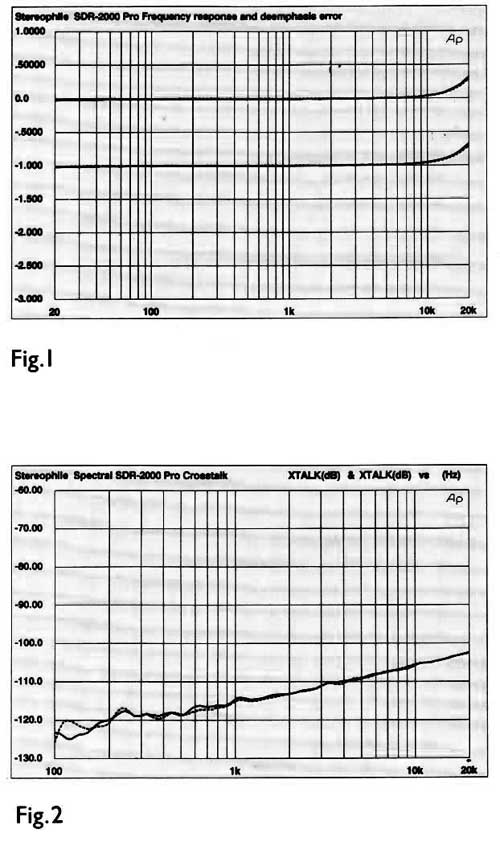
Fig. 1 Spectral SDR-2000. frequency response (top) and dc-emphasis error
(bottom) (right channel dashed, 0.5dB/vertical div.).
Fig.2 Spectral SDR-2000. crosstalk R—L (L—R dashed, 10dB/vertical div.).
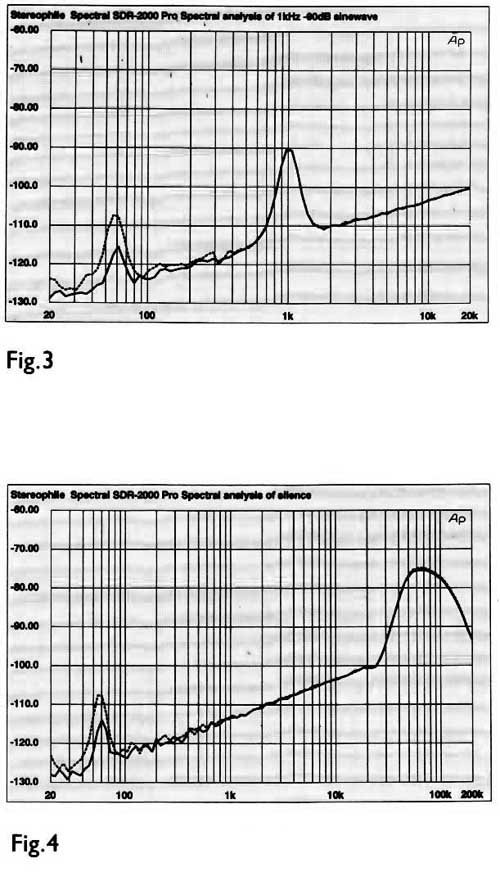
Fig.3 Spectral SDR-2000, spectrum of dithered 1kHz tone at —90.31dBFS,
with noise and spuriae (‘/ analysis, right channel dashed).
Fig.4 Spectral SDR-2000, spectrum of digital silence (s-octave analysis, right channel dashed).
Fig.4 is a wider-baud spectral analysis of the SDR-2000 Pro’s output when driven by an input signal of all zeros. We can again see the power-supply noise, but the most interesting feature of this plot is the rapid rise in noise energy above 20kHz. This noise is presumably the optional high-frequency dither generated by the PMD100 HDCD decoder/filter chip? [ this ultrasonic content is low in level, it might be a problem in non-Spectral systems that are marginally stable.] The rolloff in the noise-floor energy starting at about 60kHz is due to the analog low-pass filter, which pre cedes Spectral’s 1.2MHz-bandwidth output circuitry.
As would be expected from the UltraAnalog DACs in the SDR-2000 Pro, the linearity plot (flg5) was superb. The SDR-2000 Pro has virtually perfect linearity to below —105dB, with noise dominating the measurement below that level.
Driving the SDR-2000 Pro with a 1kHz, -90dB undithered sinewave to look at the converter’s low-level performance produced the plot offig.6. If you think this looks like a dithered sinewave, you’re right—the dither is introduced by the PMD100 decoder/filter chip. This makes it impossible to look at the undithered step transitions. Note how the dither appears to have a specific frequency around 25kHz rather than a random character—just what you’d expect after seeing in fig.4 how the dither energy is concentrated just above the audioband. [ that the higher components of the dither noise will be rolled off by the Audio Precision’s anti-aliasing filter.]
== ==
NOTE: I believe that, in their implementation of the PMD100 for the Mark Levinson No.30.5 and No.36 processors, Madrigal’s design engineers decided not to use the chip’s optional dither.
== ==
Fig.7 is the SDR-2000 Pro’s noise-modulation plot. This is one of the best-looking results I’ve seen, with very tight trace groupings. This indicates that the SDR-2000 Pro’s noise floor doesn’t shift in level or change its spectral balance as a function of input level.
Driving the SDR-2000 Pro with a full-scale mix of 19kHz and 20kHz and performing an FFT on the output created the plot of fig.8. This is the best performance I’ve measured in a digital processor. The 1kHz difference component is almost 100dB down, and no other inter- modulation products are visible. Note that the level was increased by 6dB after the measurement was taken, to compensate for the 6dB of attenuation provided by the digital filter on non-HDCD data (like the test signal).
Finally, I was initially unable to mea sure the SDR-2000 Pro’s jitter performance: the clock signal is buried inside a four-layer circuit board, and is inaccessible to a probe. Spectral provided me with a special test fixture that accessed the dock signal, but because of a ground interaction between the SDR-2000 Pro and the Meitner LIM Detector, I got readings that appeared to be invalid. If this problem can be resolved, I will present the SDR-2000 Pro’s jitter measurements in a Follow-Up.
CONCLUSION
As much as I’ve been impressed by the two other serious HDCD-based processors I’ve reviewed recently, Spectral’s SDR-2000 Pro is the best-sounding digital processor I’ve heard to date. The Spectral offers a smaller increment in performance over the $15,950 Mark Levinson No.30.5 but sounds significantly better than the $5295 Sonic Frontiers SFD-2 Mk.II. While the SDR 2000 Pro and No.30.5 shared many exceptional qualities, I thought the Spectral excelled in low-level resolution, soundstaging, and harmonic purity. The SDR-2000 Pro redefines what we can expect from the compact disc format in terms of transparency, palpability, resolution of fine detail, and rightness of timbre—particularly with HDCD encoded discs.
I can’t stress enough how important system setup is with the SDR-2000 Pro. The processor must have many conditions in its favor for it to achieve the level of performance I’ve described. Proper routing of digital cables in relation to the AC-power cord and DC ribbon cable, for example, can mean the difference between stunning musical performance and merely good sound. Further, the SDR-2000 sounded its best when used with the Spectral electronics and MIT cables.
Don’t let the SDR-2000 Pro’s $8195 price fool you: this is the state of the art in digital playback, and my first choice in digital processors—regardless of cost. What more can one say?
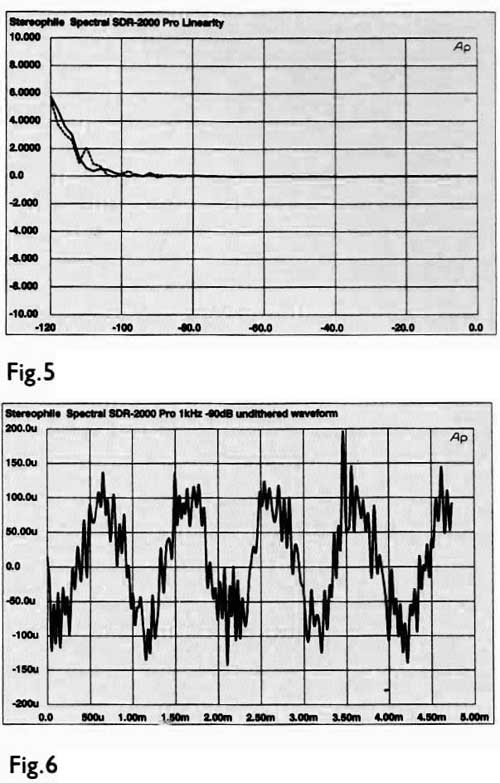
Fig.5 Spectral SDR-2000, departure from linearity (right channel dashed,
2dB/vertical div.).
Fig.6 Spectral SDR-2000, waveform of undithered 1kHz sinewave at -90.31dBFS.
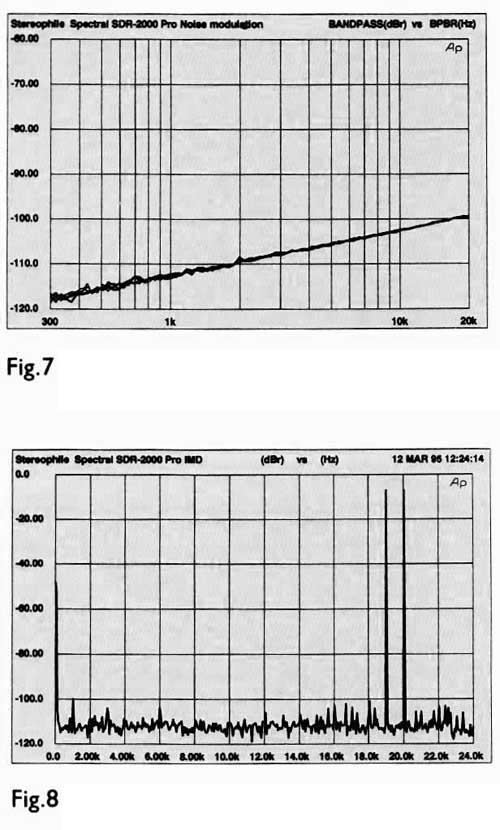
Fig.7 Spectral SDR-2000, noise modulation, -60 to -100dBFS (10dB/vertical
div.).
Fig.8 Spectral SDR-2000, HF intermodulation spectrum, DC—22kHz, 9+20kHz at 0dBFS (linear frequency scale, 20dB/vertical div.).
===
== == ==
(adapted from review in Stereophile, May 1995)
== ==
ALSO SEE: spectralaudio.com
== == ==